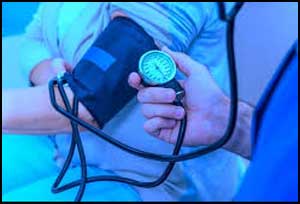- Home
- Editorial
- News
- Practice Guidelines
- Anesthesiology Guidelines
- Cancer Guidelines
- Cardiac Sciences Guidelines
- Critical Care Guidelines
- Dentistry Guidelines
- Dermatology Guidelines
- Diabetes and Endo Guidelines
- Diagnostics Guidelines
- ENT Guidelines
- Featured Practice Guidelines
- Gastroenterology Guidelines
- Geriatrics Guidelines
- Medicine Guidelines
- Nephrology Guidelines
- Neurosciences Guidelines
- Obs and Gynae Guidelines
- Ophthalmology Guidelines
- Orthopaedics Guidelines
- Paediatrics Guidelines
- Psychiatry Guidelines
- Pulmonology Guidelines
- Radiology Guidelines
- Surgery Guidelines
- Urology Guidelines
Blue light can reduce blood pressure, study suggests

Exposure to blue light decreases blood pressure, reducing the risk of developing cardiovascular disease, a new study from the University of Surrey and Heinrich Heine University Dusseldorf in collaboration with Philips reports.
During this study, published in the European Journal of Preventative Cardiology, participants were exposed to 30 minutes of whole-body blue light at approximately 450 nanometers, a dose comparable to daily sunlight -- followed by exposure to a control light on a different day. Visible blue light, as opposed to ultraviolet (UV) light, is not carcinogenic. To assess the impact, participants' blood pressure, the stiffness of arteries, blood vessel dilation and blood plasma levels of nitric oxide stores were measured before, during, and up to two hours after irradiation with both lights.
Researchers discovered that exposure to whole-body blue light significantly reduced the systolic blood pressure of participants by almost 8 mmHg, compared to the control light which had no impact. The reduction of blood pressure from blue light is similar to what is seen in clinical trials with blood pressure lowering drugs.
Besides blood pressure lowering effects, it was also uncovered that exposure to blue light improved other cardiovascular risk markers including reduction of arterial stiffness and increasing blood vessel relaxation. This further supports that light could be used to prevent cardiovascular disease, which kills over 150,000 people in the UK every year.
Researchers also found that exposure to blue light increased levels of nitric oxide which is an important signaling molecule that protects the cardiovascular system. It is believed that blue light releases from the skin into the bloodstream where it relaxes the blood vessels, increasing blood flow and decreasing blood pressure.
Christian Heiss, Professor of Cardiovascular Medicine at the University of Surrey and NHS consultant, said:
"Exposure to blue light provides an innovative method to precisely control blood pressure without drugs. Wearable blue light sources could make continued exposure to light possible and practical. This would be particularly helpful to those whose blood pressure is not easily controlled by medication, such as older people."
For more details click on the link: https://doi.org/10.1177/2047487318800072

Disclaimer: This site is primarily intended for healthcare professionals. Any content/information on this website does not replace the advice of medical and/or health professionals and should not be construed as medical/diagnostic advice/endorsement or prescription. Use of this site is subject to our terms of use, privacy policy, advertisement policy. © 2020 Minerva Medical Treatment Pvt Ltd